Bunker gear
Bunker gear (also known as turnout gear, fire kit and incident gear) is the personal protective equipment (PPE) used by firefighters. The term is derived from the fact that the trousers and boots are traditionally kept by the firefighters bunk at the fire station to be readily available for use.
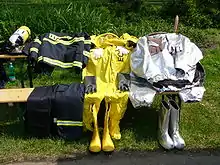


History
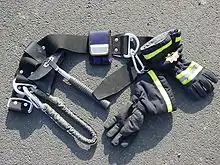
Historically, firefighters have not had access to the same level of protective clothing used today. Most fires were fought from the outside of buildings, and structures were rarely entered. Early in the history of firefighting, a firefighter's outer clothing was more for warmth and dryness than for protection from fire. In the early 19th century, felt caps were worn in various designs and were more for decoration than service; this early headgear did not provide any protection against flame or head injury but did keep water off the firefighter's face. The modern firefighter's helmet was developed in 1830 by luggage maker Henry Gratacap, who was also a volunteer firefighter in New York City.[1] Gratacap recognized the need for a well-designed helmet that provided maximum protection to the wearer.[2] This helmet is immediately recognizable today as the "New York" style of helmet, and little has changed in terms of its shape. The helmet had a brimmed front to affix a face shield, usually adorned with a company name and number. It featured eight rib sections on the dome for added rigidity and a long rear brim that channeled water away from the wearer's neck.[3]
Firefighting trench coats, made of leather or canvas and later rubber, were the precursor to modern turnout jackets. Early coats had felt or wool liners to provide warmth in winter. These layers later developed into today's turnout gear's thermal and flame protection liners. Earlier rubber coats were much longer than today's modern turnout jackets, reaching a firefighter's mid-thigh. They wore long rubber boots called "three-quarter boots" above the firefighter's knees. This interface of the boot and coat left a significant protection gap against fire. This system has since been replaced by the modern combination of a jacket, pants with suspenders, and shorter rubber or leather boots, although some departments still wear the old gear style.
The combination of modern triple-layer turnout gear with self-contained breathing apparatus (SCBA), personal alert safety system (PASS) device, and modern communications equipment is intended to provide comprehensive protection against smoke, heat, water, steam, flashovers, and even direct flame for a short time.[4] Modern turnout jackets and pants are made of fire-retardant fabrics, mainly aramids such as Nomex and Kevlar or polybenzimidazole (PBI). The National Fire Protection Association publishes the requirements for fire protective clothing under NFPA 1971: Standard on Protective Ensembles for Structural Fire Fighting and Proximity Fire Fighting, which specifies "the minimum design, performance, safety, testing, and certification requirements for structural fire fighting protective ensembles and ensemble elements that include coats, trousers, coveralls, helmets, gloves, footwear, and interface components."[5]
Station uniform
The first component of firefighting equipment is the uniform a firefighter wears around the station. Its purpose is to provide comfortable clothing that is not an obstruction when a firefighter must put on their turnout gear. Turnout gear is to be worn over the station garments during any call that a firefighter is called upon.
Another aspect of the station uniform is the station safety shoes, commonly called work boots. These shoes must be fitted with safety toes and puncture-resistant soles in most countries if the firefighter goes out on a call that does not require their turnout gear.
The United States adheres to NFPA 1975: Standard on Emergency Services Work Apparel. NFPA 1975's primary purpose is that no part of the uniform garment “ignite, melt, drip, or separate”[5] when exposed to a heat of 500 °F for 5 minutes.
Protective ensemble
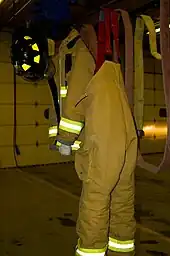
Turnout clothing includes trousers, suspenders, boots, and a jacket. Modern sets use a trouser and jacket combination. The advantage of this combination is overlapping coverage to create a protective envelope for the firefighter to operate in.
It has been noted that young children in dangerous circumstances like a building fire may be further frightened by the appearance of firefighters equipped in full turnout gear. Many fire departments have school presentations to familiarize children with firefighters and their arrival to ensure they will be calm and cooperative during emergencies.
Materials
According to NFPA 1971: Standard on Protective Ensembles for Structural Fire Fighting and Proximity Fire Fighting (and equivalent standards in other countries), all turnout clothing must have three components: an outer shell, a moisture barrier, and a thermal barrier. Separating these layers are pockets of air called "dead zones". These layers of the atmosphere and the three layers help further insulate the wearer from extreme fires. Turnout pants are typically outfitted with knee pads and leather cuffs.
The materials used for the layers in turnout trousers and coats vary but often include a Nomex or Kevlar composite. For example, the materials used by the Los Angeles City Fire Department, as found in their 2005 recruit handout, are as follows:
- Outer shell: Southern Mills, Advanced, Nomex/Kevlar blend in a "rip-stop weave" with water repellent finish.
- Thermal insulated layer: Southern Mills Caldura batten quilt material.
- Thermal and moisture barriers are sewn together for removal for cleaning, repair, and replacement from the outer shell.
- Moisture barrier: Breathe-Tex mixed with Nomex/Kevlar blend laminated cloth.
NFPA 1500: Standard on Fire Department Occupational Safety, Health, and Wellness Program and similar standards mandate that firefighters wear upright protective collars and sleeves.
Trousers

Once the need arises for firefighting personal protective equipment to be worn, a firefighter must properly don the gear. Turnout trousers are the first article of clothing that a firefighter puts on. Suspenders worn with the turnout trousers should be the heavy-duty type to stand up against the heavy weights and rigorous activities they face. Most experienced firefighters carry various tools and equipment in their turnout trouser pockets and rope and hardware they may need during an emergency. When not in use, the turnout trousers are usually scrunched around the boots for efficient and fast access when needed. The firefighter may step into each boot and pull up the trousers and suspenders.
Coat
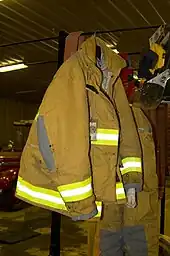
A turnout coat is the type of jacket typically worn by firefighters. Oversized pockets allow for carrying tools and equipment, and reflective safety stripes ensure that firefighters remain visible to each other. Protective coats usually have Velcro or zipper functions, enabling a firefighter to don this gear properly and efficiently. A storm flap covers this closure area and protects it against heat, damage, and loosening. Wristlets, 4-inch (according to NFPA 1500) 100% Nomex coverings along the distal end of the coat arms in with the thumb joint slips through, fit around the firefighter's hand and provides redundant protection where the skin may show between the glove and coat. They are designed to prevent burns to the wrist while preventing bunching and remaining flexible.
Overalls
Overalls are available in the same materials and specifications. Usually, an overall has a cord built around the waist to make it fit better. Because of its size, scrunching up the general around the boots is more challenging.
Boots
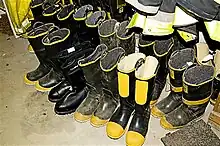
Firefighter turnout boots are usually sized like regular shoes and are made of rubber or leather with a steel toe insert. The shoes are slipped inside the legs of the trousers to maintain a barrier from the fire's heat. When the trousers and boots are not being actively used, the trousers fold down and out around the shins of the shoes, ready for quick access for the firefighter. Owing to the enormous number of potential hazards to the feet at a fire scene, turnout boots are required to be able to handle various risks. All shoes must be outfitted with safety toes and a puncture-resistant midsole plate to prevent puncture from sharp objects that may be stepped on. With such emphasis on the midsole plate, IFSTA has deemed that "if there is doubt about midsole protection, [one should go as far as to] X-ray the boot."[5]
Helmet
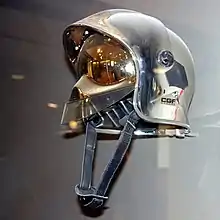

The fire helmet's first function was to shed water, but today, it is first and foremost designed to protect a firefighter from falling debris and injury to the head while fighting a fire. The secondary job of the fire helmet is to protect from heat and burns to the head. It provides electrical, warmth, and steam burn protection, a hard shell, and in some types of helmets, goggles, a face shield, or Bourkes, a two-piece short folding shield that covers the eyes. In the media, these are often seen unfolded. All three protect the firefighter's eyes during rescue and extrication operations. Fire helmets are constructed of various materials, including non-conductive materials for protection against electrical currents, carbon fiber and plastic combination for a lightweight design for comfort, and a Kevlar lining for strength and security. More traditional US fire helmets are made out of leather.
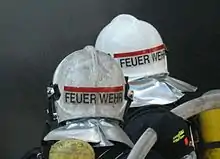
The design of helmets varies from fire service to fire service and depends on the service or department's requirements. Some helmets are fitted with a face guard or shield to protect the firefighter's face against heat, dust, water, and debris when working on a rescue or extraction call and performing fire exposure protection. In the case of exposure protection, the shield works better because it keeps more heat from the firefighter's face, but the goggles give more eye protection in extraction and rescue ops.
There are four essential components to firefighting helmets:
- Helmet shell: Well-balanced, lightweight, and designed to provide maximum protection. It consists of a front brim (which offers protection to the eyes and facial area), a rear brim (which protects the neck from debris and water run-off), and raised top (which provides stability from impact from above).
- Impact ring: A 3/8" thick sponge rubber ring to absorb impact energy.
- Helmet liner: A high-density plastic liner made of fire-retardant cotton and Nomex; completely adjustable; nape strap adjusts to cradle the occipital portion of the head firmly.
- Chin strap: A 3/4" wide, black nylon with Velcro on one end, leather-backed "postman" side buckle. The leather helps protect the skin of the cheek from the metal buckle. Previous types of helmets had been constructed of a steel outer shell with a ribbed construction for extra strength and compressed cork with a lacquer applied to the outer face of it. The design and shape of the helmet are intended to redirect water and debris from the head and neck area. It also prevents head or neck injury to the firefighter in the event of falling debris.

In Europe and some Europe-oriented countries, helmet designs vary from the U.S. designs in that they are moving towards a style without brims. The pilot-style helmets have a bill at the front of the helmet and a shape that covers more of the head. The neck is protected by a combination of a Nomex (or similar material) flash hood and a foil-faced neck curtain connecting to the helmet's rear. In most designs, the Nomex fabric also protects the area around a SCBA facepiece and the front of the neck. A commonly used helmet is the F1 helmet, although several other designs like the Dräger HPS Helmet are in use.
These helmets tend to have in-built face protection (visors) and eye protection that swivel into the helmet's shell for protection.
EN 443:1997 (Helmets for firefighters) specifies the properties demanded for protection, comfort, and durability. There are optional specifications to cater to national requirements. The new EN 443-2008 now replaces the EN 443-1997.
Flash hood/Nomex hood
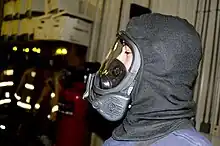
When helmets do not provide built-in protection for the ears, neck, and part of the face, firefighters wear a protective firefighting hood. These are fitted and designed to protect the firefighter’s ears, neck, and face details that the SCBA mask does not cover.
They are designed to the guidelines set by NFPA 1975. Cal/OSHA Title #8 also has regulations in California. They are made of Nomex Knit Fabric which weighs 6 ounces per square yard; they are often double-ply with only one seam running from the top center of the face opening, over the top, and down the bottom of the bib. The Nomex Knit, which is standard, is why they are commonly referred to as Nomex hoods. First, the hood is tucked into the collar. The SCBA mask is then donned, and the hood is pulled over the face seal to cover any exposed skin.
Hand protection
Many types of hand protection are available to firefighters today, the most common being the work glove and the structural firefighting glove.
Work gloves are a must for all fire services. They are used when required, but firefighting gloves are not. They allow better mobility to perform various functions, from relaying hose beds to vehicle maintenance. Work gloves are usually made of leather or a leather-like material.
Extrication gloves are similar in design and appearance to auto mechanic gloves. However, they are made of a heavier rip-proof and puncture-resistant material such as Kevlar while still lightweight enough to allow manual dexterity to operate rescue equipment and sometimes sufficient to take a victim's pulse. These are used in urban search and rescue, vehicle extrication, and related applications but are not rated for firefighting.
For an actual working fire, structural firefighting gloves must be worn. Structural gloves are usually the last piece of protective equipment to don because the fingers' free dexterity is required to perform functions such as correctly placing an SCBA mask on and accurately tightening a helmet strap. The gloves fit over the wristlets and under the distal part of the coat sleeve, ensuring full enclosure of the latter arm. Gloves are designed to protect from extreme heat and various penetrating objects and to allow dexterity. Usually, the latter is sacrificed to give adequate protection from heat and sharp objects. Unlike leather gloves, new gloves are more lightweight and don't lose their talent when they dry after becoming wet.
Variations
Proximity suit

Firefighters wear several other related types of protective clothing, which are not usually called turnout gear:
Proximity gear or a fire proximity suit is turnout gear with an outer layer of heat-reflecting metallic material, used in firefighting applications of extreme heat such as aircraft fires and some chemical fires.
Hazmat suit
Hazmat suits are designed to prevent the wearer from coming into contact with hazardous materials. Class D is a work uniform with a face shield, respirator, apron, and gloves. All other levels are worn with structural firefighter PPE to a varied degree. The highest level is A consisting of a gastight suit overtop of SCBA and turn-out gear.
See also
- Hazmat suit – Protective suit against chemical, bacteriological, and nuclear risks
- Firefighter's helmet
- PASS device – Device used to set off an alarm when a firefighter is in distress
- Self-contained breathing apparatus – Breathing gas supply system carried by the user
References
- Staff, Fire Engineering (2008-06-16). "The History of Firefighter Personal Protective Equipment". Fire Engineering: Firefighter Training and Fire Service News, Rescue. Retrieved 2023-01-05.
- "Tradition, history of the American firefighting helmet". FireRescue1. Retrieved 2023-01-05.
- "Fire Helmet, "N.Y. Volunteer Association"". National Museum of American History. Retrieved 2023-01-05.
- "How Your Turnout Gear Works". The Scene | A head-to-toe safety blog from the experts at MSA Fire. 2020-06-16. Retrieved 2023-01-05.
- NFPA 1971: Standard on Protective Ensembles for Structural Fire Fighting and Proximity Fire Fighting, 2007 Edition. National Fire Prevention Association: Boston, Massachusetts. 2007
Further reading
- NFPA 1500, "Standard on Fire Department Occupational Safety, Health, and Wellness Program"
- NFPA 1971, "Standard on Protective Ensemble for Structural Firefighting."
- NFPA 1975, "Standard on Station/Work Uniforms for Fire Fighters."